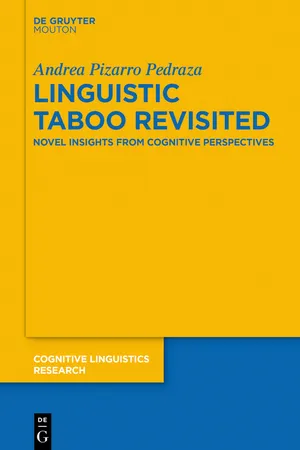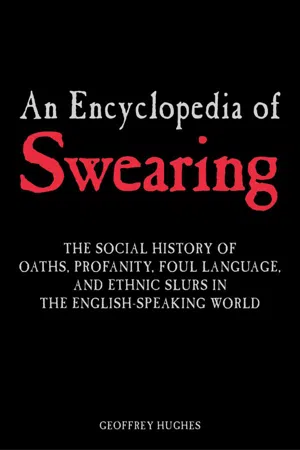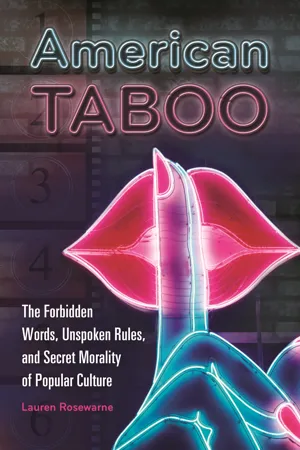Languages & Linguistics
Euphemism
A euphemism is a word or phrase used to replace a term that may be considered too harsh, blunt, or offensive. It is often used to soften the impact of a statement or to make it more socially acceptable. Euphemisms can be found in many areas of language, including politics, medicine, and everyday conversation.
Written by Perlego with AI-assistance
4 Key excerpts on "Euphemism"
- Meng Ji, Michael P. Oakes, Meng Ji, Michael P. Oakes(Authors)
- 2021(Publication Date)
- Routledge(Publisher)
With regard to manifestations of Euphemism in discourse, one of the best-known and most-quoted definitions of Euphemism is provided by Allan and Burridge (1991), who described Euphemism “as an alternative to a dis-preferred expression” (p. 11) with the aim of preserving face. The authors emphasized the relative levels of politeness intended through the use of Euphemisms, concluding that this strategy of politeness has a pragmatic dimension and depends on the context. Allan and Burridge (1991) provided one of the first models that represents ways in which Euphemisms may be formed. They determined different types of euphemistic manifestations in discourse: remodeling, circumlocution, clipping, acronyms, abbreviation, omission, one-for-one substitution, general-for-specific, part-for-whole, learned terms, borrowing, hyperbole, understatement.In keeping with the overall approach of Allan and Burridge (1991), Casas Gómez (2009) reviewed different definitions of Euphemism and adopted a pragmatic approach as well, arguing that the euphemistic process is of a social nature with a contextual function. He described Euphemism as the conceptualization of a forbidden reality with a view to attenuate that reality or concept, or, to reinforce it (Casas Gómez, 2009).Among other definitions is Warren’s (1992). She described Euphemism as being structured around three main defining features; the sensitive connotation of the referent word, the soft aspect of the alternative word, and the awareness of interlocutors of the use of euphemistic mechanisms to avoid embarrassing words. Her approach helped us to understand the transfer of the connotative aspects in the referent and its alternative from the target-language perspective. The analysis presented led to a detailed classification of the ways in which Euphemisms can be constructed, enumerating main Euphemism formation ways, namely: (a) word formation devices; (b) phonemic modification; (c) loan words; and (d) semantic innovation.For the purpose of this study, the classifications proposed by Allan and Burridge (1991) and Warren (1992) were used as the point of departure for analyzing the corpora. They adopted a pragmatic approach toward Euphemism that is aligned with the purpose of the present study. These two classifications have some overlaps, but each has specific features which can complement one another. Examples of these two classifications were provided when analyzing doctors’ strategies in communication.- eBook - ePub
- Andrea Pizarro Pedraza(Author)
- 2018(Publication Date)
- De Gruyter Mouton(Publisher)
Of all these, for the purposes of this study, we would like to return both to the distinction between taboo and interdiction, as a starting point for some reflections on the subject of Euphemism from a cognitivist standpoint, and to the identification between Euphemism as a process and substitute as a result. In accordance with the second aim of this work, different authors have observed that Euphemism is frequently identified with euphemistic substitute and that this consists simply of using the former to indicate the term that is used to replace the forbidden word and not the substitution itself, or, more exactly, the linguistic expression itself. This misunderstanding is seen clearly in traditional linguistic definitions or those within the framework of semantic structuralism, such as those by Ullmann (1964: 205), who described it as a “harmless substitute”; Baldinger (1970: 223), who considered that “a través del eufemismo se hace abstracción de la función de síntoma o de señal implicada por la palabra que es reemplazada por el eufemismo” [through Euphemism an abstraction is made of the symptom or the signal implied by the word that is replaced by it]; Lamíquiz (1974: 415), who regarded Euphemism as the “sustituto léxico que siempre ge‑ neraliza quitando semas o dando sólo el género próximo” [lexical substitute that always generalises, eliminating semes or giving only the generic term]; or Senabre (1971), who, at the time, went deeper and determined the linguistic concept of Euphemism (Casas Gómez 1993 and 1995) - eBook - ePub
An Encyclopedia of Swearing
The Social History of Oaths, Profanity, Foul Language, and Ethnic Slurs in the English-speaking World
- Geoffrey Hughes(Author)
- 2015(Publication Date)
- Routledge(Publisher)
Although many Euphemisms are self-evident, as in formulas like “four-letter word” or “go to the bathroom,” a surprisingly large number are unconscious and collective. Euphemism is a continuous process, since it is an essential mode of politeness, although there are periods, such as the Puritan and Victorian eras, when it is more pronounced and evident. All speech communities, from the most “primitive” to the most “advanced,” have taboo topics and thus demonstrate Euphemism. Observers of linguistic mores generally regard the contemporary period as having such a glut of swearing and foul language that there are few Euphemisms left. However, this is not the case, as is shown by the whole development of Political Correctness. Furthermore, the feared or prohibited semantic areas that promote the growth of Euphemism vary enormously, and include the following: the names of God and the Devil, references to death, disease, madness, being crippled, being fired, being poor, excretion, copulation, and in some societies such comparatively trivial embarrassments as references to underclothes, being fat, or having a humble occupation. Several cases are discussed under rude words. As this list shows, Euphemism is difficult to avoid: excretion, copulation, and having a humble occupation are all Euphemisms themselves; some readers will feel that crippled should be replaced by disabled. Taboo, a key factor in Euphemism, is a surprisingly recent borrowing in the language, having been brought back to England from the Pacific by Captain (James) Cook in 1777 - eBook - ePub
American Taboo
The Forbidden Words, Unspoken Rules, and Secret Morality of Popular Culture
- Lauren Rosewarne(Author)
- 2013(Publication Date)
- Praeger(Publisher)
being vulgar. Charlotte’s efforts to use language to manage her façade highlight another rationale for sex-themed Euphemism: psychology.Euphemism AND PSYCHOLOGY
A central motivation for Euphemism use is to put space between oneself and an idea. There are numerous psychological reasons why this might be done; two that I propose in this section relate to (1) putting distance between the self and something considered too horrible to speak about explicitly and (2) self-esteem rationales. Both of these reasons have notable applicability to a discussion of sex.Euphemism and Dissociation
While news reports readily use Euphemisms to discuss rape—indecent assault, carnal knowledge, attack, and abuse, for example—the use of Euphemism by victims is particularly relevant for this section, highlighting some of the psychological underpinnings of Euphemism use. When linguistic anthropologist Shonna Trinch undertook research with women who had experienced domestic violence, she noted that 80 percent who had experienced marital rape had used Euphemisms in their descriptions.9 Psychologists Judith Parker and Deborah Mahlstedt, in their work on rape, similarly noted that victims “use a variety of linguistic resources to manage their (un)willingness to acknowledge their sexual assault.”10 By using Euphemisms, a distance can be established between the victim and the word rape
Index pages curate the most relevant extracts from our library of academic textbooks. They’ve been created using an in-house natural language model (NLM), each adding context and meaning to key research topics.
Explore more topic indexes
Explore more topic indexes
1 of 6
Explore more topic indexes
1 of 4



